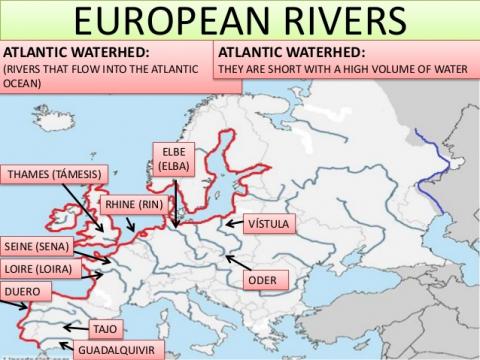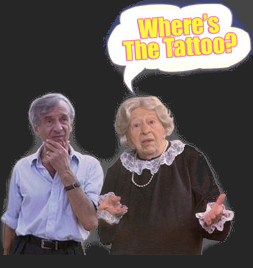The political misfortunes of the German Reich
From the Handbook for Schooling the Hitler Youth
Chapter Ten: The Political Area of the German Folk (Handbook online is here)
The Rhine, Danube (running West to East from the Rhine all the way to the Black Sea), and the Vistula were considered the life arteries of the historic German Reich.
The following has been edited for greater brevity -cy
The boundaries of the German Reich - the political territory of our people – have experienced many changes since the beginning of German history. During periods of unity of political purpose, the frontiers of the state extended beyond the borders of the German population area. Periods of internal dissension and lack of unity, however, led to the involution of the state's territory behind the population area.
After the close of the great eastern colonization movement, the Rhine, Danube and Vistula rivers were the life arteries of the German Reich. All of the German population area lay within the boundaries of the German Reich. In all directions the boundaries of the state as well as the military lines of defense were pushed far beyond the frontiers of our population area.
After the downfall of the Hohenstaufen, the German Reich sank to a mere shadow of what it once was. The German princes continued to make themselves independent and the little states gained the upper hand. There no longer existed any central power which would have been strong enough to hold the frontiers against the onslaughts of neighboring peoples.
These weaknesses were taken advantage of by the Reich's neighbors; consequently almost all of them at one time or another established themselves on German soil. Swedes, Danes, the French, Italians, Poles and Russians have tried repeatedly to win for themselves land belonging to the German people. Thus the land along the Vistula was occupied by the Poles for a time. In the north the island of Rugen and a part of Upper Pomerania was still in the hands of the Swedes in 1815, and Schleswig-Holstein still in Danish possession in 1866. Likewise, for centuries France stood on the German Upper Rhine.
The losses the German Reich suffered were due primarily to the lack of unity within the Reich, and to the anti-German policies of the Habsburg Kaiser. The great powers of Europe also contributed their part.
The Swiss Confederation, Flanders, Netherlands and Belgium
In 1315 the Austrian Habsburgs wanted to annex to their dynastic holdings the land belonging to the Swiss Confederation. In the course of long struggles, until 1388, the Confederation was able to offer successful resistance and save itself from the Habsburgs. As a group of independent communes, it remained within the Reich subject to the old German Empire; in other respects, it went its own way. After the Thirty Years' War (1648), Switzerland became an independent state. Of the 24 Swiss cantons, 17 are German, 6 Latin, and one mixed. The Germans are the most significant historically and profess German culture in its entirety.
As a defense against French attacks (1302) the cities of Flanders joined together, and during the following centuries secured a considerable degree of self government within the framework of the Reich. During the period of the Reformation they accepted the reformed teachings. When the Netherlands fell to the House of Habsburg, the latter attempted, with cruel force, to win the land back to Catholicism again.
The great war for the liberation of the Netherlands began (1568-1648) and the German Reich offered no support to the Dutch brothers in their hard fight. When the northern provinces obtained their freedom, therefore, they broke away from the Reich and made themselves independent. Since then, the low Germans in Holland have taken on a cultural development of their own and have developed their own written language.
Although the southern provinces of the Netherlands belonged to Habsburg Austria until the time of Napoleon, they followed the same cultural developments as Holland. In 1830 they, together with Luxembourg, formed the new state of Belgium. Two thirds of the territory of Belgium is an old Germanic, German population area. In spite of that the Latin Walloons rule the state even today. The Flemish section of the population has a hard time fighting for its rights.
In 1867 France extended its hand to Luxembourg. Prussia opposed the move and Luxembourg was declared neutral. Until 1919 it remained in the customs' union with the German Reich. Then this tie also was dissolved. And today French has become the preferred language of the educated, and the second official language. The prevailing speech of everyday life, however, is German.
Thus four independent buffer states were created between France and the German Reich. The Reich had to bear the cost of this for by far the largest part of the territory of these states was torn away from the German population area. [See map in online book here]
Thirty Years' War
After the Thirty Years' War Prussia grew even stronger to a point where it was actually the dominant power in the German Reich. Austria, bearer of the old Imperial crown, had turned toward the southeast and conquered territories with large sections populated by non-Germans. The task of governing an empire of many peoples soon caused its Imperial German tasks to fall into the background. Thus, after the collapse of the old Reich and the removal of the Napoleonic danger, Imperial thoughts revived in the German people and the question arose: who should take over the leadership of the new Reich. It came to a showdown between Prussia and Austria (1866), out of which Prussia emerged as victor. The new German Reich was finally established under Prussian leadership in 1871. Austria withdrew from this Reich and turned more emphatically toward the southeast.
Along with Austria and almost unnoticed, the principality of Liechtenstein also broke away from the German Reich and became a completely independent state leaning heavily toward Austria. After the World War, Liechtenstein turned toward Switzerland and today remains in that sphere of economic influence. It's culture is pure German and it consciously fosters its German art.
The Germans have also suffered territorial losses by a process of denationalization of the German population area. For example, about 1550, after France had attained political unity as a national state, its thrust-to-the-Rhine policy became evident. The attack was first prepared by clever cultural propaganda. This policy succeeded in getting in under the frontier walls and shoving the German people bit by bit towards the east. It can be seen by the names of old German cities such as: Ryssel (Lille), Doornik (Tournay), Kamerich (Cambrai), Wirten (Verdun), Tull (Toul), and Brienz (Besancon), which today have names and a character completely French and are surrounded by French nationals. The father of the French Rhine policy was the Roman Catholic Cardinal Richelieu. He recommended:
The building and opening of gates in order to make possible an entrance into the neighboring lands of the Germans. This must take place slowly with great caution, meekly, [with] attitudes carefully disguised.
Warlike measures were needed to to support this cultural advance. The French King Louis XIV finally resorted openly to a policy of war robbery. Thus was Burgundy, western Lorraine and French Flanders lost. From 1684 France stood implanted on the Upper Rhine. Not until 1870-71 could Alsace-Lorraine get back home to the Reich for a period of 50 years.
Also on the southern borders the German population area had to register losses. The striving of Italy for the passes over the Alps had since 1859 yielded territory settled by Germans on the Tessiner frontier and on the Rathorn. In 1866 Italy obtained Friaul, a territory with a predominantly German imprint.
Although the frontiers of the Austrian dual-monarchy lay far beyond the boundaries of the Germans, the southern Slavs, Hungarians and Czechs succeeded in winning large sections of the German population area. Thus the Germans in Bohemia were continually being pushed back to the border line. Carniola, a German territory for a thousand years, was completely Slavonicized. On Prussian soil, too, the Poles succeeded in putting themselves in an ever stronger position and pushing the Germans further and further back. Preparations were made for dividing up the region, with the plan eventually carried out in the treaties of Versailles and Saint Germain.
Treaty of Versailles
The peace dictate which ended the World War brought to fulfillment all the geo-political wishes of the enemy powers directed against the German population area. Germany was to be excluded forever from the ranks of the great nations. Merely a little German reservation was to be preserved for our people. If the results did not go quite as far as our opponents dreamed, that is really due to the lack of unity within their own ranks. Nevertheless, large sections of the German population area were taken away, contrary to the announced right of self-determination of peoples. [See map in online book here]
The dictate of Versailles robbed the German Reich of the following territories:
Alsace-Lorraine, 14,521 sq. kilometers with 1,634,260 Germans ceded to France without a plebiscite.
Eupen and Malmedy, 1036 sq. kilometers with 49,494 Germans, to Belgium without an election; a subsequently ordered referendum was prevented.
North Schleswig, 3993 sq. kilometers with 40,172 Germans, united with Denmark.
Memel, 2657 sq. kilometers with 71,781 Germans, was torn away without a plebiscite. In 1923 was placed under the authority of Lithuania.
The Vistula corridor, 23,000 sq. kilometers with 1,077,300 Germans and German-sympathising Kaschubes, annexed to Poland without a plebiscite. By this action, East Prussia was completely excluded from access to the Vistula.
Danzig, the old German Hanseatic city, almost 2,000 sq. kilometers, made a free state, but restricted politically and economically in favor of Poland.
The province of Posen (without Netzegau) 20,000 sq. kilometers, fell to Poland without a plebiscite. Though thickly settled with Poles, the southern part would have chosen to stay with the German Reich.
Eastern Upper Silesia, 3270 sq. kilometers with 890,000 inhabitants, more than 60% German, was annexed to Poland contrary to the results of a March 1921 plebiscite.
The little land of Hultschin, 316 sq. kilometers and 48,466 inhabitants who are 90% German, was given to Czechoslovakia without a plebiscite.
Finally, the German Reich was deprived of its German colonies, and Luxembourg was forced to withdraw from the German customs' union.
Treaty of Saint Germain
By the treaty of Saint Germain the following territories were taken away from the German territory of Austria:
The Sudeten area, 26,600 sq. kilometers with 3,071,304 Germans, given to Czechoslovakia without a pletiscite.
The land of Ödenburg, part of the territory of Burgenland, was united with Hungary in an improperly conducted plebiscite.
South Styria, 6,000 sq. kilometers with 75,000 Germans, given to Yugoslavia without a plebiscite.
Parts of South Carinthia, 332 sq. kilometers with 10,000 Germans, awarded without a plebiscite to Yugoslavia (Miestal) and Italy (Kanaltal).
German South Tyrol, 7720 sq. kilometers with 232,659 Germans and 19,605 Ladinern (politically German) without a plebiscite.
The Anschluss of Austria with Germany was forbidden.
The dictate treaty contained many other provisions which curtailed the independence of the German Reich and Austria from a military and economic point of view. It's unnecessary to explain them all since they've now been done away with by the Leader's forceful policies.
Since the war Germans have been partitioned among 15 states; 14 lands wedge into the German population area; 25 neighboring peoples live in direct contact with the German peoples. The result is that German youth is being brought up according to 15 different ideologies, that the boundaries of numerous countries separate Germans from Germans.
These facts make it a duty of the German people not to confine its thinking and dealing merely to the political area of Germany, but to learn to think in terms of their folk policy.
- 775 reads










